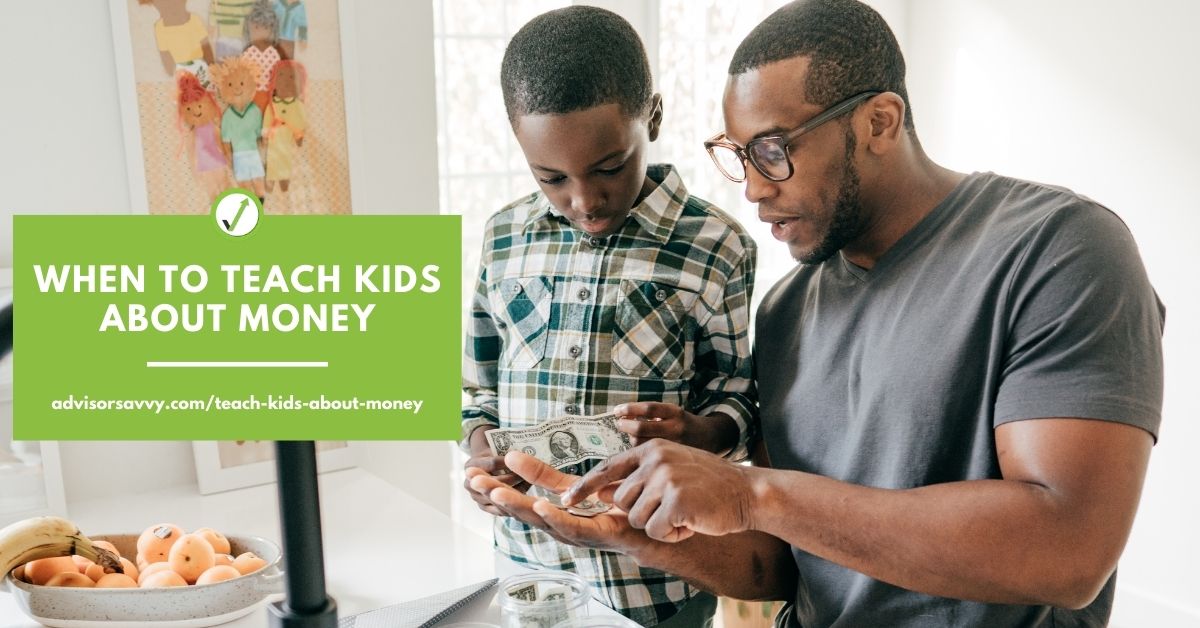
“I just want my child to succeed,” is probably something almost every parent has said at one time or another. And a big part of setting up a solid foundation is by teaching your kids about money.
Now, you certainly don’t have to get them investing when they’re still in diapers. But the fact of the matter is, money kinda really does make the world go-’round — and schools are only just starting to include basic financial skills into their curriculum. Chances are, your entire k-12 school experience didn’t cover the basics, let alone information like investing or mortgages.
Weaving money management lessons into everyday life can give your kids a foundational understanding of concepts like saving and smart budgeting. Financial literacy, for the win!
Let’s look at age-appropriate financial lessons for kids, and how you can integrate these into your daily activities.
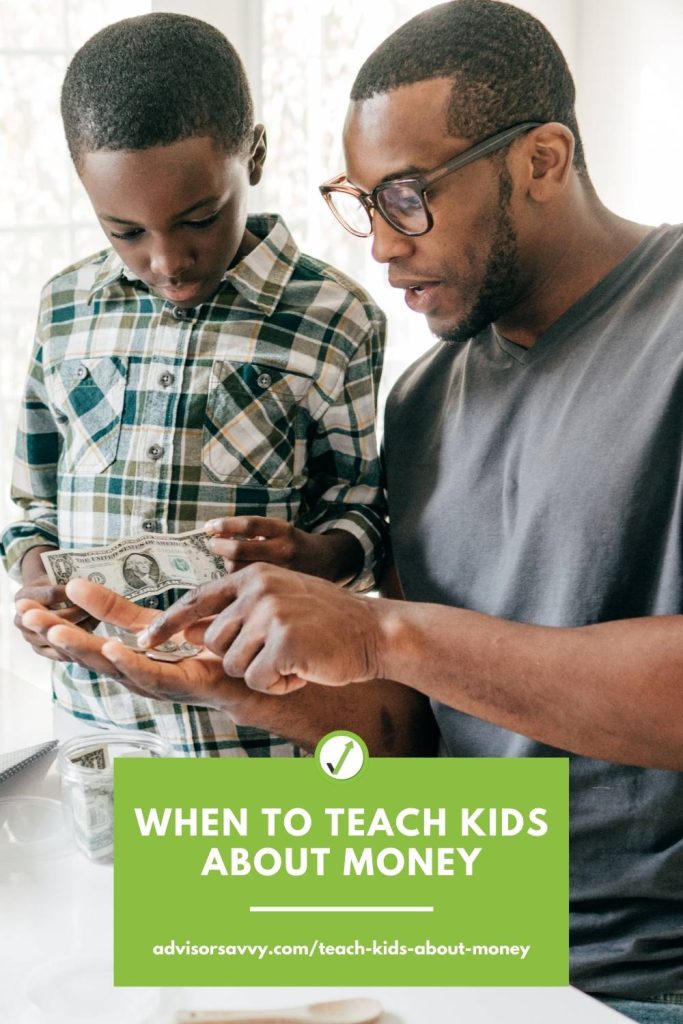
Table of contents
What is financial literacy?
The simplest definition of financial literacy? Knowing how to manage your money. But you know how the concept of ‘literacy’ isn’t just reading and writing but all aspects of how we communicate and understand each other? Well, the aforementioned money management can be broken down into a LOT of subtopics, and they all ladder up from each other.
First, you have the basics like saving and budgeting. Then, there’s learning about donating and being a smart consumer. Finally, you move into lessons on credit, investing, taxes, and long-term planning. Being financially literate also includes concepts like setting goals for yourself and learning about delayed gratification.
Ultimately, financial literacy is now considered an essential life skill.
Did you know? In Canada, every November is Financial Literacy Month. All month, the Financial Consumer Agency of Canada features education information and resources around a theme.
Why is it important to teach kids about money?
According to Beth Kobliner — an expert on personal finance for young people — money habits are already set by age seven. At 3, kids can handle and understand basic money concepts. Combine this with the fact that kids are basically sponges, picking up behaviours and cues quickly, it’s important to start these lessons early and weave them into all aspects of life. And, as the below video shows, money lessons can be fun — and involve things like pizza!
And it’s not just about teaching these money foundations. It’s also about making sure your kids are confident with money.
A recent survey from The Canada Life Assurance Co. asked Canadians to rate their financial knowledge. They were then quizzed on a variety of financial topics. The average score? 71%. Meanwhile, 41% of respondents claimed high confidence in financial topics. Even though Canadians have a fairly healthy baseline of financial knowledge, there’s a disconnect with their confidence in this knowledge.
Teaching kids money basics needs to go hand in hand with empowering them to make informed decisions for themselves. Even if they end up making a mistake, the lessons are still there. And let’s be real — mistakes hurt a lot when they involve money!
When to teach kids about money
When it comes down to it, as explained above, starting early and making “money talks” a part of everyday life can go a long way. There are age-appropriate topics to cover at every stage, and most topics, like saving, can be adapted as your child ages. For example, starting with a piggy bank for your preschooler, leading eventually to a bank account. (More on piggy banks a little further down!)
As ABC Life Literacy Canada explains:
“Little ones can understand the basic concept that money pays for things. School-age kids can consider the difference between wants and needs and save up for a new toy or game, while older teens will benefit from learning about compound interest and banking.”
The key is consistency. Money is a big part of life. Learning about it shouldn’t stop once your child has the basics down.
Money lessons during financial hardship
Money topics are still often seen as taboo, and there’s also that natural instinct to shield your kids from problems at home. But, as mentioned, kids can sense when something is wrong. First off, be honest with them and sensitive to their concerns, keeping age-appropriateness in mind. In other words, it’s maybe not the best idea to explain your debt history to your 6-year-old.
Most of all, kids just want to know that everything will be ok. Don’t know an answer to a question? Reassure them that you will find out the answer and let them know. And even more important — flashing-lights-alarm-bells important — never fight about money with your partner in front of your kids, or talk negatively about money stresses.
Related Reading: What Is The Lifelong Learning Plan?
How to teach your kids about money – Age by Age
One of the first things you need to do before diving into a talk with your kids about money? Look inward. Take a good look at how you approach money.
It’s one thing to teach your kids the practical basics — how much to set aside from their allowance or managing a first credit card. But it’s another to teach money values and different approaches to it. Look at your own money habits. Are you a spender or saver? Do you keep a lot of cash or do bring out a card for most purchases? Make sure your own habits are in check. Kids are observant and you need to practice what you preach. Kids are also incredibly honest, so they’re going to keep you in check!
The bottom-line: an open and honest (within reason) conversation about money can go a long way in establishing healthy and responsible financial habits. This is especially true when your kids are getting older and might be getting a credit card, a part-time job, or taking on student loans.
And finally, be firm. Stick to your guns when you set limits or rules for money management. At the same time, give them some room to make some mistakes. It can lead to a valuable teaching moment.
Let’s look at each age group, and the kinds of money lessons you can teach your kids at every step. One thing to keep in mind? You know your kid best. Use this as a gauge for when they’re ready to move along in their lessons.
Pre-school and kindergarten
The absolute, very basics? Introducing your kids to coins and bills. (Well, the very VERY beginning is learning numbers, but let’s work from after that point!) Show them that each amount looks different and point out markers of each (eg. hockey players on the $5, the polar bear on the toonie).
Explain to your kids that money is used to buy things. Let them see you pay for your everyday purchases, and show them how money works. If you’re in a store that’s having a slower day (and if the cashier seems patient or doesn’t need to leave the area to do another task), count the money out loud or let them swipe your card. If you’re grocery shopping, point out prices and show your child the receipt.
Bonus: most of this can easily translate to online shopping or banking, especially for groceries or if you’re comparison shopping. Let them hop on your lap and watch the process!
Allowances
It might feel like a young age to start an allowance, but as long as you explain the importance of saving a portion, try giving them the equivalent amount of their age, per week (eg. $6/week for a 6-year-old). Many experts agree that allowances should not be tied to household chores, on the basis that helping around the house is part of everyday family life. Allowance should be given for learning to manage money.
Expert Beth Kobliner elaborates: “If you tie chores to allowance, that money becomes an external motivator for them — and worst of all, paying for chores can backfire.” One idea? Give your kid a small amount of money explicitly for doing chores or special tasks outside of their regular ones.
Be consistent with their allowance, and be firm that it’s a set amount. If it’s spent in one place, that’s it — a lesson that should be carried all the way until they start their first job.
As mentioned, as soon as they start getting an allowance, teach your kids to set a portion aside. The classic method is by giving them three labelled jars or piggy banks: one each for saving, giving, and spending. When your child gets money (allowance, birthday money, etc), they’ll divide it between the three jars. Some experts might suggest an even split, but others put the decision into the child’s hands. They can decide, once the ideas of saving and giving are properly explained, how to split the money.
Elementary and middle school kids
As mentioned above, this is a good age to start talking about the difference between needs (food, a place to live) vs. wants (a flashy new toy or gadget) and inviting your kids to sit in on straightforward family budget discussions.
Maybe your child wants something that’s a bigger purchase like a new bike or a beginner musical instrument. Help them think through why they want it if it’ll be worth it, and how to set a budget for it. Empower them to start engaging with the process, and explain the value of delayed gratification. Many experts suggest opening a bank account at this age as well.
Get your kids involved in grocery planning, budgeting for the holidays, and planning a family trip. Talk about how you’re setting aside money every month for your future retirement and how you’re saving for their university or college education. Let them help you flip through flyers to find the best deals and clip coupons. Explain that if something sounds too good to be true, then it probably is — a valuable lesson in a lot of ways!
This is a fairly broad age range, so use your judgement on when to incorporate specific topics. What matters is that you start to bring them into bigger family money talks and let them take more responsibility with their money.
The truth about advertising
Another important topic of discussion is advertising, both from traditional avenues like print ads or tv and social media. Kids see ads every day, so explain what is being sold to them, along with how and why. Teach them that advertising can play a part in the aforementioned needs and wants. Many ads push still problematic values (eg. excessive use of Photoshop/impossible beauty standards, hyper-consumption etc.), so get in front of it by teaching them to be media savvy — and ultimately, a smarter consumer. This is definitely a conversation to have often and to keep it up well into high school.
High school students
Time for your kid’s first job! Whether they’re helping out in a family shop, looking after the neighbourhood kids, or slapping on a headset to work the drive-thru, it’s a big step and one that’ll really kick their financial literacy lessons into overdrive. For starters, explain how taxes work if they seem a little bummed out that their take-home pay feels low.
Next, if you had been using the jar method of saving up until now, it’s time to open a basic chequing account with a debit card. You can incorporate this lesson earlier (especially if they start doing babysitting or odd jobs for neighbours or helping at the family business earlier), but most employers will do a direct deposit.
Does your child want to start saving for those really big-ticket items like a car? Ladder up your budget lessons (and fold in an explainer on insurance, too). You’ve already discussed how you’re saving for their education, but get them in on the action, too. Encourage them to look for scholarship opportunities, in addition to setting aside money. Look at the costs of all potential schools, considering both tuition and living expenses. Explore borrowing options together, and be open to answering questions about the student loan application process.
‘Money Talks’ with teenagers
Conversations at this age can be even more open and honest. Involve them even more in family financial decisions. Tell them about your job, and even how much you make. Encourage their curiosity about money, finance, and even investing! Start teaching your teens about credit, credit cards (especially those tempting store cards), credit scores, interest, and earning their own money. Did you maybe have a bit of trouble with a credit card in your younger days? Be open about that. Ask your bank if they have a credit card suitable for a student, or if they can give them a card that’s attached to your account.
If you think they’re ready, explain how you invest your money. Explain investing vehicles like TFSAs and RRSPs. If you use self-directed apps like Questrade or Wealthsimple, show them how they work. If you work with a planner or advisor, explain how they help you manage your money.
University and college students/early adulthood
Time for the bird to fly from the nest! Hopefully, all your teachings will have built to this moment, and your child will feel confident and secure in their financial literacy.
As they prepare to leave home and set up in a residence or their own apartment, teach your child about household or ‘adult’ budgeting (which they would’ve had some early exposure to with those early money talks). Continue encouraging responsible credit card use, student loan use, saving, and investing.
Above all, make sure your kids know they can talk to you about money issues, even after they strike out on their own. It’s likely that you’d rather help them deal with something like a large medical expense instead of avoiding it because they’re on a budget.
How to save up money as a kid
As we’ve covered, saving money is just one of the core healthy financial habits that can start at a young age. One approach that we recommend comes from personal finance educator and best-selling author (and member of our advisory panel!) Kelley Keehn. Her latest book, Rich Girl, Broke Girl: Save Better, Invest Smarter, And Earn Financial Freedom features a section advising parents on how to instill such habits in their kids. Here’s Keehn’s savings strategy for kids, starting with a single piggy bank, laddering up to a real bank account, and finally incorporating a lesson in credit cards.
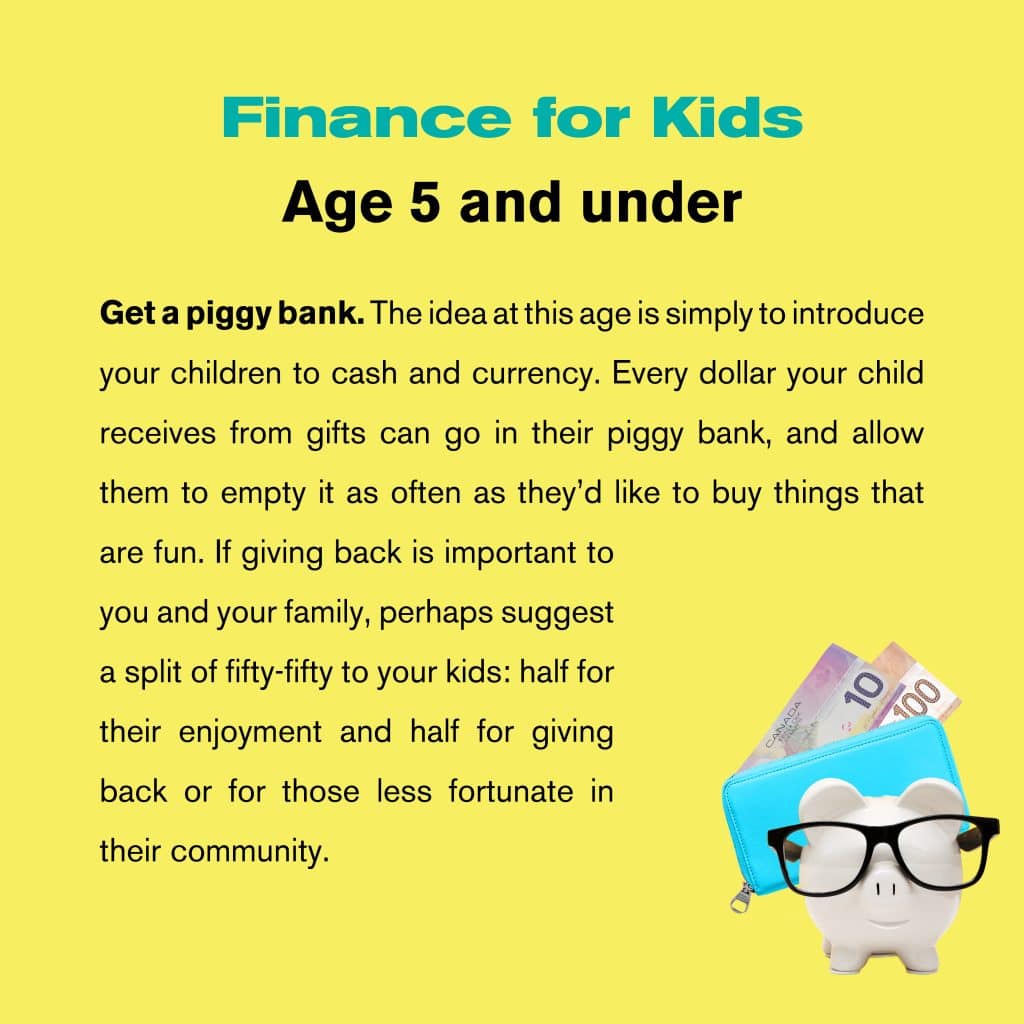
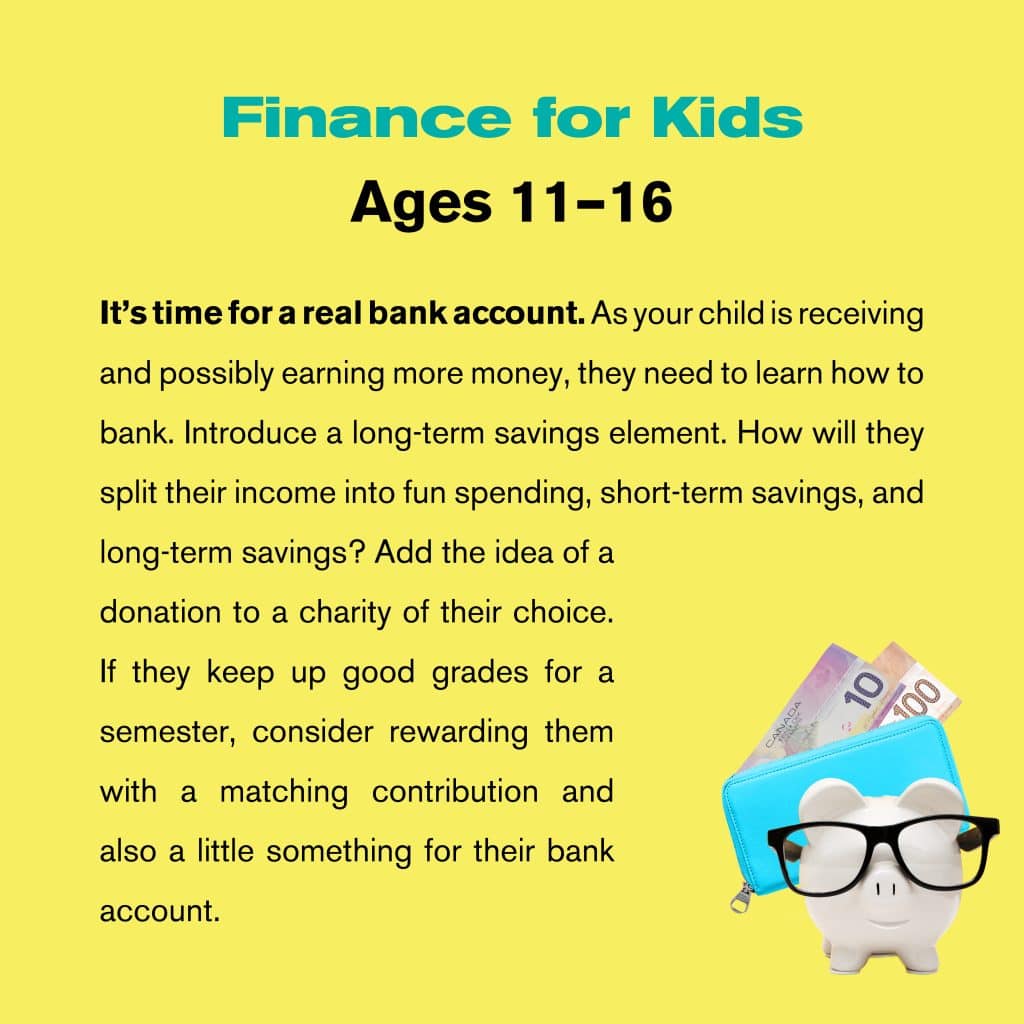
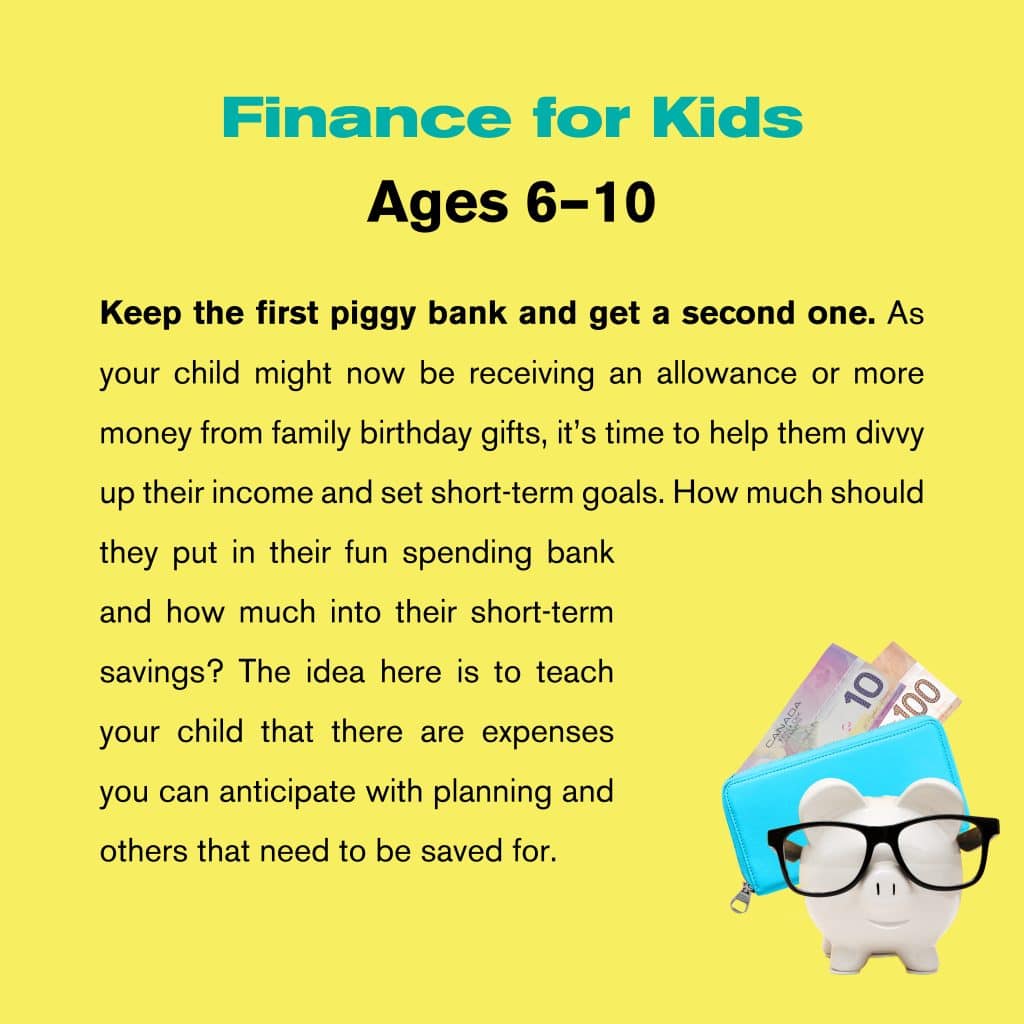
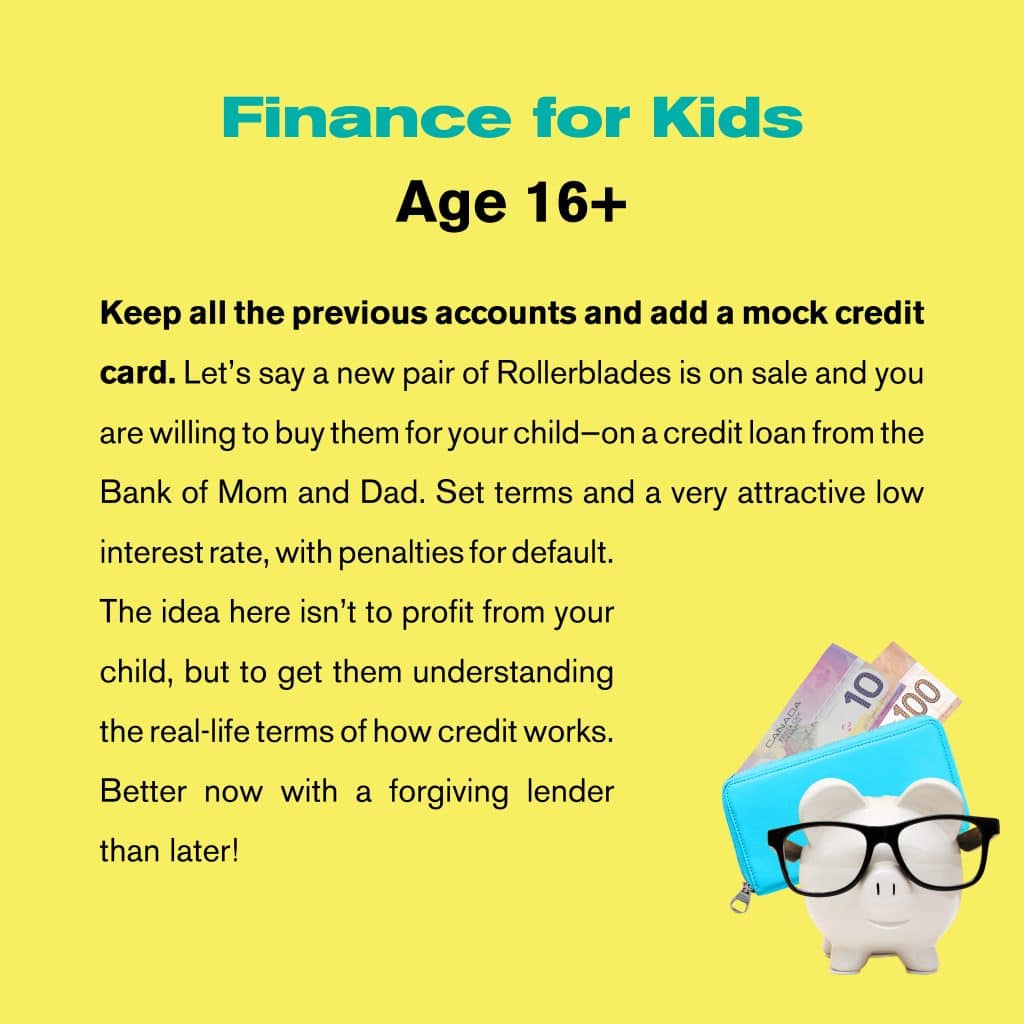
Recommended resources for teaching kids about money
There are lots of resources out there to help you teach kids about money, from printouts to games to guides, and more. Some of these are geared a bit more to the United States, but the foundational lessons remain the same! Just make sure that when practicing, you use Canadian bills and coins.
For starters, the Bank of Canada Museum has a whole section of activities and games, including printable practice money, activity templates (with instructions), a colourable piggy bank print-out, and an ‘Economics of Suppertime’ activity about budgeting for middle schoolers. Most of the resources are geared toward teachers, but many can be adapted for one-on-one lessons with your child.
You can also find plenty of toys like play money (for example, this set from Amazon) or toy cash registers to help your youngest kids.
Additional Resources
Here are some extra resources for you to explore that might be perfect for your kids.
- Peter Pig’s Money Counter is an app game (only available for iPhone and iPad) that helps teach kids ages 4+ about making budgets and setting money aside.
- CPA Canada has free interactive online financial literacy workshops for grades 4-12. You can download workshop materials and view the workshop presentation online.
- WorksheetWorks.com have a section of printables covering basic money problems, like making change.
- Break out a board game! Try the classic Pay Day or a coin counting game like Money Bags.
- Math anxiety is VERY real, and it’s often tied to a bad experience with math as a child or young adult. Feeling nervous or panicked about math can have an impact in how you handle your finances in the future. If you think your child can handle it (and if you think you can be patient in helping them), Scholastic Canada has tons of PDF math printables for all ages.
Books to help parents teach kids about money
One book we recommended in our article about investing books is Raising Money-Smart Kids: How to Teach Your Kids About Money While Learning a Few Things Yourself by Robin Taub.
A CPA, Taub originally her book through CPA Canada in 2011 and published an updated version in 2020. Taub outlines each life stage, acknowledging our increasingly mobile and cashless world. Her goal is to explain why it’s important to teach kids about money, the best ways of explaining these topics, and a detailed look at the key topics for each age.
Another book that’s on our radar is Money Savvy Kids: The Best Ways to Teach Your Children About Money For a Strong Financial Future by Gordon Pape and Deborah Kerbel. Pape is one of Canada’s leading personal finance experts, and he has a number of books under his belt. Kerbel is his daughter, and together, they talk about teaching the value of money, whether allowances are actually a good idea, teaching smart shopping skills, and saving for college or university. (Note: This book is from 2013, so while most of the practical information is still relevant, the world is a bit different now!)
Takeaways
Teachable moments exist in all aspects of childhood — especially when working at building your child’s financial skills. Making sure they have a solid foundation when it comes to money involves not just making sure they can calculate sales taxes or set aside part of their allowance. It’s about instilling confidence.
Work these money moments into day-to-day life. After all, we use money literally every day! Answer the questions your kids ask and talk through even the potentially uncomfortable conversations. Keep it positive, stick with it, and before long, their financial literacy will be soaring.
Your financial situation is unique, and we can help you find the best advisor for your needs. Just fill out our short questionnaire.
